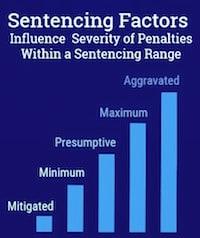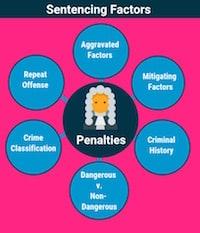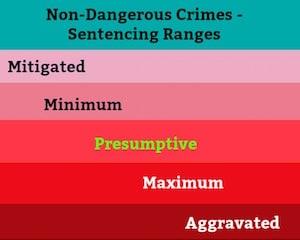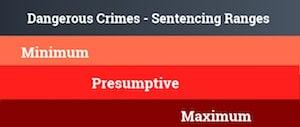Arizona Sentencing Factors and Guidelines
Criminal Defense Attorney for Felony Charges Mesa AZ
What are Sentencing Factors?

Sentencing factors are aspects surrounding the defendant or their criminal case that can influence penalties for a conviction.
The Court may impose penalties that are more lenient or more severe, within a sentencing range based on these factors.
Sentencing factors are recognized at the Federal level, under the United State Sentencing Commission Guidelines; and the State level under Arizona Criminal Code Sentencing Provisions, and A.R.S. 13 Chapters 7, 8, and 9.
A.R.S. 13-701 includes a list of aggravated and mitigating factors in prison sentencing. A.R.S. 13- 751 includes factors that influence capital sentencing.
Relevant non-statutory factors may also be considered as they pertain to the defendant, the defendant’s character, history, or circumstances surrounding the crime.
Common sentencing factors include nature of the crime; court findings in the case; aggravated circumstances; mitigated circumstances; prior criminal history; first offense v. repeat offense; dangerous verses non-dangerous crime; nature of injuries or harm to a victim; the defendant’s character and background; the defendant’s remorse for committing the crime; risk of future criminal activity; mental and physical health; cooperation and good behavior of the defendant; testimony from the victim, victim’s family, law enforcement, counselors, and other entities with familiarity to the incident or defendant, and the recommendations in the presentencing report.
Certain offenses have specific factors to consider such as in the case of drug crimes. For drug offenses, a significant sentencing factor is the quantity of illegal drugs found in a person’s possession. The higher the quantity, the more severe the penalties. If the amount of the particular illegal drug equals or exceeds the statutory Threshold Amount, under A.R.S. 13-3401. (36), a higher sentencing range of penalties will apply.
Who Will Decide My Sentence?

The presiding judge will decide what penalties will be imposed within a specific sentencing range outlined in the Arizona Criminal Code Sentencing Provisions.
The exception to this currently, is in the event of capital cases. If the prosecution is seeking the death penalty the jury must decide unanimously.
Arizona has different sentencing ranges for specific crimes and classifications of crimes. Each sentencing category has a range of penalties that can be imposed from the least to the most severe.
The judge has a wide range of discretion to choose which category of penalties will be imposed within the sentencing range that applies.
Generally a judge bases this decision upon evidence presented in the case, sentencing factors that apply, and data gathered in the Presentence Report.
What is a Presentencing Report?

A Presentence Investigation Report (PSIR) is a resource used by the judge that provides facts surrounding the case and defendant, to assist them in sentencing.
Before the sentencing take place in Maricopa County Superior Court, the judge will request a Presentence Report under the Arizona Rules of Criminal Procedure 26.4.
In Maricopa County this is completed by the probation department. The probation screener will meet with the defendant, and gather information to be submitted to the court in the form of a report. The report will include sentencing guidelines information for the judge to consider, based on the data and results of their investigation.
The presentence report will contain information about the defendant based on screenings, risk assessments, statements from the defendant, statements from other case relevant parties, background, prior criminal history, character, physical and mental health, financial information, exceptional circumstances surrounding the defendant or crime, sentencing factors, and guideline information.
With certain exclusions and exception under Rule 26.6, the court is required to allow disclosure of the report to the prosecution, defendant’s criminal defense attorney, or to a self-represented defendant, prior to sentencing.
If the prosecution or defense has objections to any of the information gathered or presented in the presentencing report, they may file an objection in writing to the court under Rule 26.8.
The court has the discretion of taking action on the objection. Some actions include removal of the specific information from the report, ordering a new report, requesting a new screener and report, or sealing the report.
Whether the defendant enters a plea agreement, or is found guilty after trial of a felony offense, sentencing for the conviction will be scheduled for a future date. Under the Arizona Rules of Criminal Procedure Rule 26.3, this takes place between 15 and 30 days from the date of the conviction.
Under Rule 26.3 (2) the judge may pronounce sentencing immediately upon conviction in limited jurisdiction courts, generally in the case of misdemeanors. However, this may be extended out to 30 days at the request of the defense, prosecution, or victim, at the court’s discretion.
What are the Categories Within a Sentencing Range?

Penalties for felony convictions can differ substantially within the sentencing ranges. The sentencing ranges are based on the classification and nature of the charges.
The court will weigh mitigating factors against aggravated factors in considering which penalties should be imposed.
When there are two aggravated factors involved and no mitigating factors, the judge will likely impose the maximum or aggravated sentencing.
If there are two mitigating factors involved and no aggravated factors the judge will generally impose the least severe, minimum or mitigated sentencing.
The categories differ in the Arizona Criminal Code Sentencing Provisions for dangerous crimes v. non-dangerous crimes.
For non-dangerous crimes the penalty categories are mitigated, minimum, presumptive, maximum, and aggravated sentencing.
For dangerous crime sentencing, there are three categories minimum, presumptive, and maximum. Though they do not have mitigated or aggravated categories, the dangerous offense prison sentences are more severe within the minimum, presumptive, and maximums.
A.R.S. 13-702 outlines sentencing ranges and guidelines for first-time felony crimes which calls for a presumptive sentence unless aggravated or mitigating factors apply.
Below are some illustrations of how the different ranges impact the penalties for a class 2 non-dangerous offense:
First offense non-dangerous offense – No priors
- Mitigated – 3 years in prison
- Minimum – 4 years prison
- Presumptive – 5 years prison
- Maximum – 10 years prison
- Aggravated – 12.5 years prison * Two or more aggravated factors required
Felony with history of prior felony – Category 2
- Mitigated – 4.5 years in prison
- Minimum – 6 years prison
- Presumptive – 9.25 years prison
- Maximum – 18.5 years prison
- Aggravated – 23 years prison * Two or more aggravated factors required
What is Dangerous Offender Sentencing?

Dangerous offenses are crimes against victims.
Dangerous offender sentencing includes longer prison terms, and other penalties for convictions that result from dangerous offenses.
A.R.S. 13-105 (13) describes dangerous crimes as those where a deadly weapon was displayed, discharged or used, or that involve intentional serious physical harm to the victim.
Sentencing ranges for dangerous repetitive crimes and, dangerous crimes against children (DCAC) include increased penalties for historical and predicate prior offenses. Below are examples of sentencing ranges for a Class 2 dangerous offense, and the penalties for the respective sentencing ranges:
First felony dangerous offense:
- Minimum – 7 years prison
- Presumptive – 10.5 years prison
- Maximum – 21 years prison
Felony dangerous offense with One historical prior:
- Minimum – 14 years prison
- Presumptive – 15.75 years prison
- Maximum – 28 years prison
Felony dangerous offense with two historical priors:
- Minimum – 21 years prison
- Presumptive – 28 years prison
- Maximum –35 years prison
The prosecution will present aggravated circumstances attempt to seek the most harsh penalties. It is important that you retain an experienced criminal defense attorney who can counter those arguments with mitigated factors, so that they can be fairly weighed against each other by the judge.
Criminal Defense Attorney for Felony Charges in Greater Phoenix AZ

If you face criminal charges in Arizona, the ideal situation is to be able to get your case dismissed. While this occasionally does happen, the majority of felony cases in Maricopa County are resolved before trial.
Any Felony charge in Arizona is serious and exposes a person to prison sentencing. If you were arrested on felony charges it is important that you obtain effective representation by a qualified criminal attorney. James Novak of The Law Office of James Novak is an experienced criminal defense attorney, and former Maricopa County prosecutor. If retained James Novak will protect your rights and defend your charges.
There may be defenses that can be used to challenge your charges or the evidence that the prosecution plans to use against you. Defenses will be heavily based on the circumstances surrounding your case and the nature of the charges. If your constitutional rights were violated, or the evidence against you is weak or compromised, it is often possible to get material evidence suppressed so that it is not used against you. This often leads to a dismissal of charges.
If retained James Novak will work hard to get the best possible outcome in your charges. Some favorable outcomes include but no limited to: dismissal of the charges; dismissal of a portion of the charges; reduction in classification of charges; reduction of penalties; or elimination of the risk of getting maximum or aggravated penalties.
Defense for the sentencing stage is crucial. Whether you enter a plea agreement or take your case to trial, criminal defense for sentencing is crucial. If you are convicted, and aggravated circumstances were present, the prosecution will seek the most severe penalties possible such as maximum or aggravated sentencing. Criminal Defense Attorney, James Novak will look for mitigating factors that may apply to your case, so that the judge can weigh them against those aggravated factors to avoid harsh sentencing. When no aggravated factors exist, and mitigating factors surround the case, James Novak will fight for a mitigated or least severe sentence.
James Novak of the Law Office of James Novak defends those facing criminal charges in Phoenix, Mesa, Chandler, Gilbert, Tempe, and Scottsdale AZ. You can also complete our on-line contact form on the website. Find out how to get criminal defense representation and resolution for your charges today. If you were charged with a crime, call James Novak of the Law Office of James Novak at (480) 413-1499 and speak directly with experienced criminal defense attorney, James Novak.












